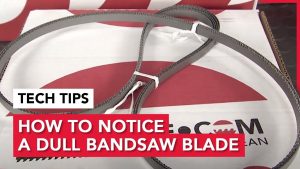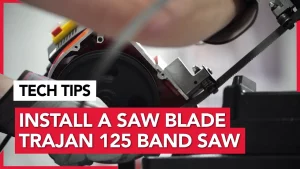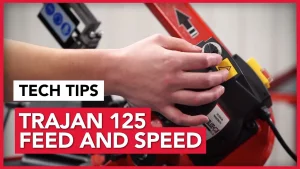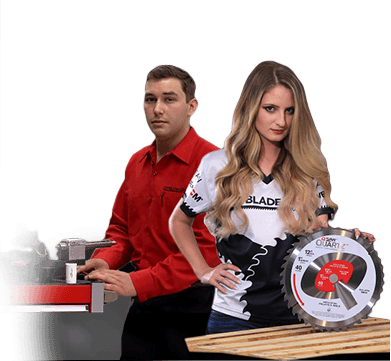The world of bandsaw blades might seem complicated, but the dedicated team at Sawblade.com are experts at simplifying it. They aim to deliver high-quality blades straight to your doorstep, ensuring every piece is carefully crafted with precision. Today, we’re diving deep into their welding process, with an inside look guided by Kenneth Oyer.
Let’s get into the heart of the matter and explore the world of bandsaw blades from the perspective of measuring to welding and beyond.
The Sawblade.com Weld Process
Before we delve into the details of measuring bandsaw blades, it’s crucial to understand the rigorous process through which these blades are produced. After all, the blade’s performance largely depends on its manufacture and welding.
At Sawblade.com, the weld process starts right from the arrival of raw materials, manufactured with cutting-edge equipment. Once these materials land at their weld shop, they’re unloaded and kept in line for the subsequent orders. SawBlade.com, being a web-based company, operates on a first-in, first-out basis, ensuring a seamless and efficient workflow.
The weld process at SawBlade.com involves several critical steps:
- Custom cut-off machine: After receiving an order, the material is cut using a custom cutoff machine. This ensures unparalleled accuracy in length set and tooth spacing.
- CNC welding machines: The blades are then moved to a CNC welding machine, ensuring a perfect weld and subsequently annealing the blade. This annealing process removes brittleness and allows the weld to be more flexible.
- Grinding: Once the blades have been welded and annealed, they’re moved to a grinding machine that dresses the gullet, removes slag from the top and bottom of the blade, and squares up the back.
- Packaging: After grinding, the blades are broken down, packaged individually based on their tooth size, and secured in transportation packaging to ensure safe and undamaged delivery.
More about the welding process can be found here.
Understanding Bandsaw Blades: A closer look
A bandsaw blade’s performance significantly depends on its proper usage and maintenance, and the key to this is understanding its structure and function. A bandsaw blade is characterized by its length, width, tooth set, and tooth spacing, all of which are carefully accounted for in the Sawblade.com production process.
Understanding the details of your bandsaw blade is vital, particularly if you’re working on a project that requires precision and durability. Whether you’re a hobbyist working on a home project or an industrial user, you’ll want to ensure your bandsaw blade is suited to your needs.
For tips on identifying a dull bandsaw blade, check out this resource.
Measuring Bandsaw Blades: The Step-by-Step Guide
Measuring a bandsaw blade may seem like a daunting task, but it’s simpler than you might think. Here is a step-by-step guide to help you measure your bandsaw blade accurately:
- Measure the Blade Length: Stretch out the blade and use a tape measure to get the total length. Always measure from the back of the blade for the most accurate reading.
- Measure the Blade Width: This measurement is taken from the back edge to the tooth tip. Different blade widths are suitable for various applications.
- Identify the Tooth Set: The tooth set refers to the left-to-right arrangement of the teeth on the blade. This is important for determining the blade’s cutting path.
- Count the Teeth per Inch (TPI): Finally, count how many teeth there are in one inch of the blade. This will determine the blade’s cut speed and finish.
Knowing how to measure your bandsaw blade will help you choose the right blade for your tasks. If you’re looking for a comprehensive guide on how to fold a bandsaw blade, you can find it here.
From Order to Delivery: An Unmatched Journey
Sawblade.com ensures fast and reliable service by shipping out 95% of orders on the very day they come in. The remaining 5% are dispatched first thing the next morning. The blades are carefully packaged and secured for transport to ensure they reach you safely and undamaged. A tracking number is promptly provided to keep you updated about your blades’ whereabouts and estimated arrival time.
Bandsaw Blade Maintenance Tips
While Sawblade.com’s blades are designed for longevity, how you handle and maintain them can significantly affect their lifespan and performance. Here are a few maintenance tips to ensure your bandsaw blade stays in optimal condition:
- Regular inspection: Check your blade regularly for signs of wear or damage. This can include broken or missing teeth, cracks, or rust. Refer to this guide on how to identify a dull bandsaw blade.
- Proper blade speed and feed: Always ensure you’re using the correct blade speed and feed for your specific cutting task. Using the wrong settings can lead to premature blade wear or even damage. Use this handy bandsaw blade speed & feed calculator for help.
- Proper material positioning: Ensure your material is correctly positioned before cutting. A misaligned cut can cause unnecessary strain on your blade. More tips on positioning your material can be found here.
Sawblade.com: Delivering Quality With No Middleman, No Markup
Sawblade.com is more than just a producer of saw blades. They’re creators of what Kenneth Oyer describes as an “industrial ballet,” where every step is carefully choreographed to ensure the utmost quality. Their mantra of “No Middleman, No Markup, No Problem. Go Direct!” is a testament to our commitment to delivering direct-to-consumer quality and value.
By offering their products directly to consumers, SawBlade.com eliminates any potential markup from middlemen. This allows them to maintain their high quality standards while still offering competitive prices.
In conclusion, Sawblade.com’s commitment to excellence shines through in every aspect of their work, from the precise manufacture and weld process to the fast and secure delivery of their products. Whether you’re a hobbyist or a large-scale industrial user, their bandsaw blades promise to deliver the performance and reliability you need for your cutting tasks. With Sawblade.com, you can always expect “No Middleman, No Markup, No Problem.”






